

Jackery SolarSaga 100W Portable Solar Panelġ. Jackery Portable Power Station Explorer 240 IGreely Solar Panel to 8mm Adapter Cable DC 8mm ConnectorĮLECTOP Solar Panel Connector to DC 8mm Adapter Cable
Solar power converter professional#
However, any professional installer should ensure that you have the right size inverter. If you pair an inverter with a solar array that is too large, it will void the warranty. Please note: every solar inverter comes with a recommended solar PV array size. It all depends on whether you can afford the initial upfront cost of multiple microinverters or optimisers. What’s more, you’ll get more electricity from your solar panels with microinverters or power optimisers, which means larger savings on your energy bills and higher Smart Export Guarantee (SEG) payments. So, microinverters cost more to buy in the first place, but their longevity might mean that you’d end up spending a similar amount on string inverter replacements. In contrast, microinverters and power optimisers typically come with a 25-year warranty, and will often last as long as your solar panels. However, there are a handful of premium string inverters that come with 12-year standard warranties (e.g. Not only will this make you less likely to damage your inverter, but you’ll also save more money.Ī string solar inverter will usually last around 10 years before needing a replacement. A 3 kW inverter is able to power up to 3,000 watts continuously. It would make sense, then, to get a 3 kW inverter, as opposed to a 3.5 kW inverter. Given that solar panel installations rarely generate at their maximum level, but inverters usually do, it makes sense to get an inverter that's rated slightly below your solar PV array's maximum level.įor example, a south-facing 3.5 kW solar PV system in southern England will generate around 3,000 kWh of electricity each year. If your inverter is too large, there won’t be enough electricity to get it going, and the small amount of power that is being generated by your panels will go to waste.Ĭonversely, if you flood your inverter with too much electricity, you'll limit how much AC electricity it can output. It’s important that the amount of electricity flowing through your inverter generally stays somewhere between the initial input voltage and the maximum input voltage. Well, it’s never quite as simple as ‘my solar PV system is 4kW, so I need a 4kW inverter’.Įach solar inverter has an ‘initial input voltage ’ (the minimum amount of electricity required to get it fired up), and a ‘maximum input voltage ’ (the total amount of electricity it can handle before it gets… too fired up). Maintenance is also trickier to undertake, as each microinverter is located on the roof (underneath each panel). The main disadvantages? The higher cost is obviously the main setback, but if your solar PV system is sometimes unavoidably immersed in shade, microinverters might be your best bet. Also, you’re able to monitor the performance of each panel, and quickly identify any faults.
Solar power converter crack#
If a solar panel is affected by shading, or its microinverter is having issues, everything else will just crack on. The main advantages? Most importantly, your high-performance panels aren’t held back by the bad ones. The merging of each panel’s electricity only takes place once it has been converted into AC. Although more expensive (costs are detailed below), they work together to get much more out of a solar PV system.Ĭrucially, there’s one microinverter per panel, meaning that each solar panel’s DC electricity is converted separately from another panel’s DC electricity. If a string inverter is like one big independent bear, microinverters are like a pack of small wolves. This sounds like a fairly huge disadvantage, but if you keep all your panels out of the shade then this will never be an issue. If one panel is affected by a bit of tree shading and its output drops, the output of your entire system will fall to that level. The main disadvantages? With a string inverter, your solar PV system is only as effective as its weakest point. The main advantages? More affordable than microinverters, and fairly easy to maintain due to a single, accessible location.

All your panels are essentially working together as one big unit, and all their output is flowing through the same box (normally located in a loft or garage). Usually up to 14 panels are wired together in a ‘string’ (this is a figurative term), sending all their electricity to one inverter.Īnd yes, as you may have guessed, this gives the string inverter a lot to do. It functions as a lone operator, processing the DC electricity of all your solar panels. A string inverter (or centralized inverter) is the cheapest of the three options.


 0 kommentar(er)
0 kommentar(er)
